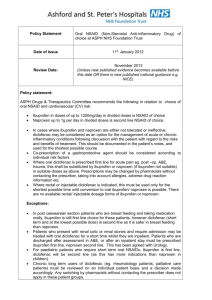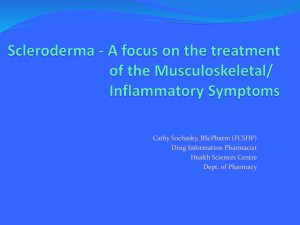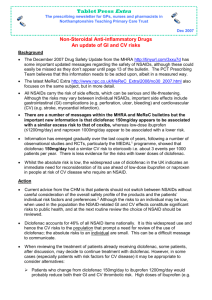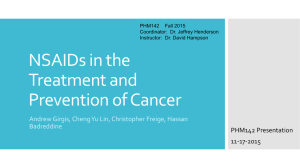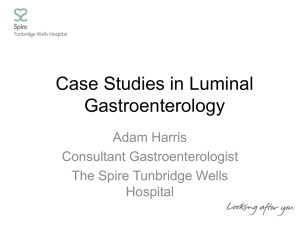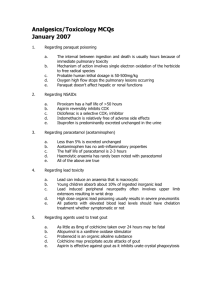Other NSAIDs
advertisement
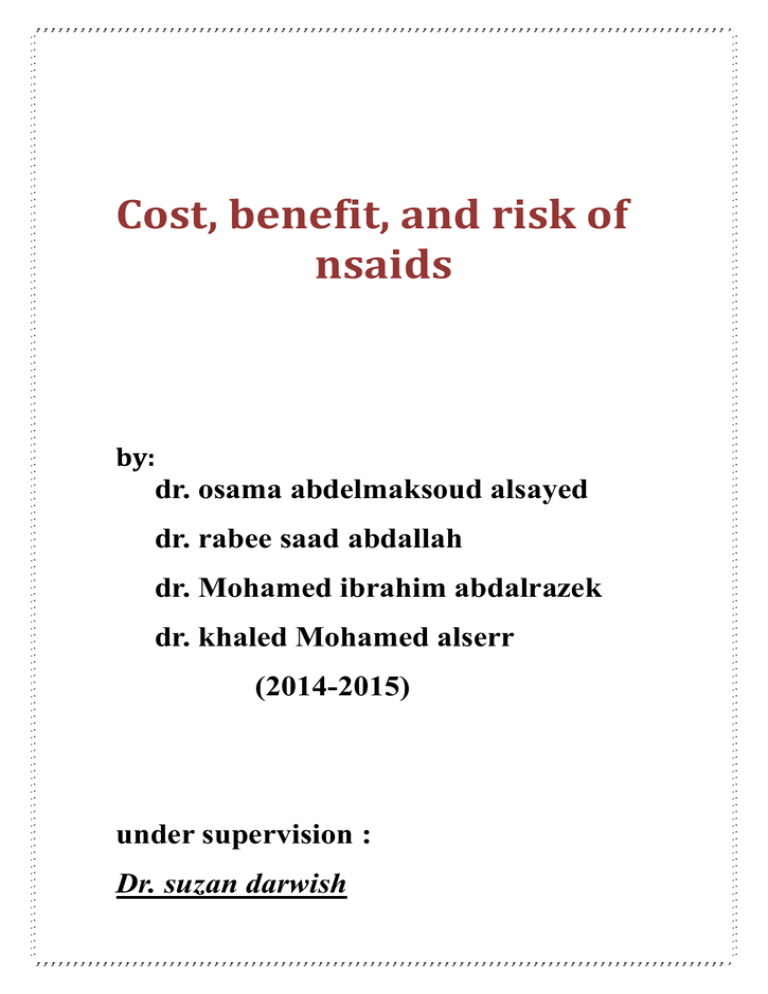
Cost, benefit, and risk of nsaids by: dr. osama abdelmaksoud alsayed dr. rabee saad abdallah dr. Mohamed ibrahim abdalrazek dr. khaled Mohamed alserr (2014-2015) under supervision : Dr. suzan darwish Non-Steroidal Anti-Inflammatory Drugs Comparison Uses Types Mechanism of action Differences between NSAIDs Side effects Contraindications Cost Conclusions Nonsteroidal anti-inflammatory drugs (NSAIDs) are among the most commonly prescribed medications worldwide. They relieve pain and inflammation in many disorders. Nonsteroidal anti-inflammatory drugs have anti-inflammatory, analgesic, and antipyretic effects and inhibit thrombocyte aggregation. NSAIDs are used primarily to treat inflammation, mild-to-moderate pain, and fever. NSAIDs also are included in many cold and allergy preparations. NSAIDs block the Cox enzymes and reduce prostaglandins throughout the body. As a consequence, ongoing inflammation, pain, and fever are reduced. Since the prostaglandins that protect the stomach and support the platelets and blood clotting also are reduced, NSAIDs can cause ulcers in the stomach and promote bleeding. Uses NSAIDs are usually indicated for the treatment of acute or chronic conditions where pain and inflammation are present. Nonsteroidal anti-inflammatory drugs are powerful analgesics, especially for nociceptive pain. NSAIDs also are effective in some neuropathic pain syndromes when used with other analgesics. NSAIDs are indicated for the symptomatic treatment of the following conditions: Rheumatoid arthritis. NSAIDs are particularly useful in the inflammatory forms of arthritis (such as rheumatoid arthritis) and, sometimes, in the more severe forms of osteoarthritis. Osteoarthritis Acute gout Inflammatory arthropathies: ankylosing spondylitis, psoriatic arthritis, Reiter's syndrome Dysmenorrhoea (painful menstruation), menstrual cramps Headache and migraine Postoperative pain Mild-to-moderate pain due to inflammation and tissue injury Back pain and sciatica Sports injuries, sprains, and strains Dental pain Pain from kidney stones (renal colic) Reduction of fever Prevention of blood clotting (Aspirin only) Note: NSAIDs do not cure the diseases or injuries. Types of NSAIDs There are many different types of NSAIDs, which are categorized according to their chemical structures: Salicylates: aspirin (Ascriptin, Bayer, Ecotrin) diflunisal (Dolobid, Diflunisal) salsalate (Argesic SA, Disalcid, Salflex, Salsitab, Mono Gesic) Arylalkanoic acids: diclofenac sodium (Voltaren) diclofenac potassium (Cataflam) indomethacin (Indocin) etodolac (Lodine) sulindac (Clinoril) tolmetin (Tolectin) Pyrroles: ketorolac (Toradol) Arylpropionic acids (profens): ibuprofen (Motrin, Advil) ketoprofen (Orudis, Oruvail) dexketoprofen () naproxen (Naprosyn, Alleve) fenoprofen (Nalfon) flurbiprofen (Ansaid) oxaprozin (Daypro) Enolic acids (oxicams): piroxicam (Feldene) meloxicam (Mobic) lornoxicam tenoxicam (Mobiflex) Fenamates: mefenamic acid (Ponstel) meclofenamate (Meclomen) niflumic acid tolfenamic acid flufenamic acid Pyrazolones: metamizole (dipyrone) phenazone (antipyrine) aminopyrine (aminophenazone) propyphenazone phenylbutazone Sulphonanilides: nimesulide Napthylalkanones: nabumetone (Relafen) COX-2 Inhibitors: celecoxib (Celebrex) etoricoxib (Arcoxia) parecoxib (Dynastat) Acetaminophen, ibuprofen, naproxen, and ketoprofen are available over-the-counter in the United States. Mechanism of action NSAIDs work by suppressing the production of prostaglandins. Prostaglandins are chemical messengers that mediate inflammation, fever and the sensation of pain. NSAIDs block the production of prostaglandins by inhibiting the action of an enzyme, cyclooxygenase (COX). This enzyme is responsible for converting precursor acids into prostaglandins. Prostaglandins formed via COX-1 activity control renal perfusion, promote platelet aggregation and provide gastroprotection by regulating mucous secretion. Prostaglandins formed via COX-2 activity mediate pain, inflammation, fever and inhibit platelet aggregation. In the periphery NSAIDs work by decreasing the sensitivity of the nociceptor to painful stimuli induced by heat, trauma, or inflammation. In the central nervous system, they are thought to function as antihyperalgesics and block the increased transmission of repetitive incoming signals to higher centers. In effect, they modulate perception of pain caused by repetitive stimulation from the periphery. Since they function by modulation of the perception of pain, they may be useful when given in the preoperative period and may reduce the need for postoperative analgesia. The anti-inflammatory activity of NSADs in descending order: indomethacin > diclofenac > piroxicam > ketoprofen > lornoxicam > ibuprofen > ketorolac > acetylsalicylic acid NSAIDs that inhibit both COX-1 and COX-2 enzymes are named non-selective NSAIDs. NSAIDs that mainly inhibit COX-2 enzymes are named COX-2 inhibitors (Coxibs). Classification of NSADs by selectivity to cyclooxygenase (according to “Drugs Therapy Perspectives”, 2000): Aspirin Indomethacin Ketoprofen Pronounced selectivity towards COX-1 Piroxicam Sulindac Moderate selectivity towards COX-1 Equal inhibition of COX-1 and COX-2 Diclofenac Ibuprofen Naproxen Etodolac Meloxicam Nimesulide Nabumetone Pronounced selectivity towards COX-2 Celecoxib Differences between NSAIDs The principal differences among NSAIDs lie in the time to onset and duration of action. Also, these drugs vary in their potency and how they are eliminated from the body. Another important difference is their ability to cause ulcers and promote bleeding. The more an NSAID blocks COX-1, the greater is its tendency to cause ulcers and promote bleeding. Aspirin is a unique NSAID but because it is the only NSAID that is able to inhibit the clotting of blood for a prolonged period (4 to 7 days). This prolonged effect of aspirin makes it an ideal drug for preventing the blood clots that cause heart attacks and strokes. Most other NSAIDs inhibit the clotting of blood for only a few hours. Bromfenac was recently approved by the FDA for the treatment of postoperative inflammation and reduction of ocular pain in patients who have undergone cataract extraction. Earlier bromfenac was removed from the market because of reports liver damage associated with its use. Celecoxib has a sulfonamide structure and is contraindicated for patients with known sulfa allergy. Dexketoprofen is available as the tromethamine salt -- dexketoprofen trometamol. Dexketoprofen is the S(+) enantiomer of the racemic compound ketoprofen. Clinical studies showed that dexketoprofen has good analgesic and safety profiles, comparable to those of other NSAIDs7. Diclofenac is relatively long acting (6 to 8 hours) but it has a relatively very short half-life. Diclofenac is also a unique member of the NSAIDs. There is some evidence that diclofenac inhibits the lipoxygenase pathways, thus reducing formation of the leukotrienes (also pro-inflammatory autacoids). There is also speculation that diclofenac may inhibit phospholipase A2. These additional actions may explain the high potency of diclofenac - it is one the most potent NSAIDs. As an analgesic, diclofenac is 6 times more potent than indomethacin and 40 times as potent as aspirin in the phenyl benzoquinone-induced writhing assay in mice. Diclofenac use increases the risk of heart attack and stroke. Etodolac, with regard to its anti-inflammatoryproperties, is approximately 50 times more active than aspirin, three times more potent than sulindac, and one-third as active as indomethacin. Although etodolac is no more potent than many other NSAIDs, a low incidence of GI side effects is an important therapeutic advantage. Fenoprofen has less potent in anti-inflammatory action than ibuprofen, indomethacin, ketoprofen, or naproxen. Flurbiprofen was found to be 536-fold more potent than aspirin and 100-fold more potent than phenylbutazone. Oral flurbiprofen is half as potent as methylprednisolone. Flurbiprofen is 26 times more potent than ibuprofen as an antinociceptive. Ibuprofen has the lowest risk of causing GI bleeding. Indomethacin, a very potent COX inhibitor, besides its high cardiovascular risk, has a significant GI toxicity and many central nervous system side effects. Indomethacin should not be used by children <14 years and during pregnancy. Indomethacin is still one of the most potent NSAIDs in use. It is also a more potent antipyretic than either aspirin or acetaminophen, and it has about 10 times the analgesic potency of aspirin. However, its beneficial analgesic effect is definitely overshadowed by pronounced side effects. Ketoprofen, unlike many NSAIDs, inhibits the synthesis of leukotrienes and leukocyte migration into inflamed joints in addition to inhibiting the biosynthesis of prostaglandins. Ketoprofen stabilizes the lysosomal membrane during inflammation, resulting in decreased tissue destruction. Although it is less potent than indomethacin, its gastrotoxicity is about the same. Ketoprofen may cause photosensitivity. Ketorolac is the most potent and most effective NSAID analgesic, with efficacy comparable to opioids4. The analgesic effect of 30 mg of ketorolac is similar to 10 mg of morphine. Anti-inflammatory activity is achieved only at doses higher than those needed for analgesia. Ketorolac has the highest incidence of side effects, and is, therefore, not used for more than five days. Lornoxicam is unique among the enolic acid derivatives in that it has a rapid onset of action and a relatively short half-life (3 to 5 hours). Meloxicam was initially introduced as a selective COX-2 inhibitor. However, it is less selective for COX-2 than is celecoxib. Meloxicam causes fewer GI complications than piroxicam. Metamizol is a potent and promptly acting analgesic and antipyretic. Its antiinflammatory activity is poor. Metamizol was banned in the USA and some European countries due to several reported cases of agranulocytosis. It has been extensively used in India and other European countries. Moreover adverse effects data collected over 4 decades shows that risk of toxicity with metamizol is lower than with aspirin. Nabumetone represents a new class of nonacidic prodrugs. Nabumetone offers distinct advantages over other NSAIDs with regard to low incidence of GI side effects, ulcers and bleeds. Based on available data, nabumetone does not appear to be associated with increased cardiovascular risk5. Nabumetone may cause photosensitivity. Naproxen provides effective relief in acute traumatic injury and for acute pain associated with migraine, tension headache, postoperative pain, postpartum pain, pain consequent to various gynecologic procedures, and the pain of dysmenorrhea. Naproxen has a lowest risk of provoking heart attack. It may cause photosensitivity. Oxaprozin has a rapid onset of action and a prolonged duration of action (half-life ranges from 26 to 92 hours). It is mainly used as an anti-inflammatory agent. It also has uricosuric properties and is used in the treatment of gout. Oxaprozin may cause rash and mild photosensitivity. Piroxicam has a long plasma half-life (38 hours), which permits a single daily dosing. Piroxicam is indicated for long-term use in rheumatoid arthritis and osteoarthritis. Its gastrotoxicity is relatively high. Sulindac, an analog of indomethacin, is unique among the NSAIDs in not inhibiting prostaglandin synthesis in the kidneys 6. So, it may be one of the safest drugs for treating osteoarthrosis in older people. Sulindac may cause increased liver enzymes. Comparative efficacy: which NSAID is the best? It is a common misconception that all NSAIDs are therapeutically equally efficacious and any one of them could be used for the given condition. For example, ankylosing spondylitis responds better to a particular NSAID like indomethacin. It is probably related to its stronger inhibition of prostaglandin synthesis. Oxaprozin, aspirin, ibuprofen, indomethacin, naproxen, and sulindac have comparable efficacy in the treatment of rheumatoid arthritis. Oxaprozin, aspirin, naproxen, and piroxicam have comparable efficacy in osteoarthritis. The analgesic effect of 10 anti-inflammatory drugs was compared using a single-blind method in 90 patients with rheumatoid arthritis. Each patient received two different drugs, for three days each and each drug was evaluated in 18 patients. After the trial, the patients considered which of the drugs they preferred. The greatest relief from pain was achieved by diclofenac, indomethacin, naproxen and tolfenamic acid, each of these being preferred by the majority of patients and being significantly better than the least effective drugs ketoprofen and proquazone. Acetylsalicylic acid, azapropazone, carprofen and ibuprofen were considered intermediate in efficacy. Side Effects NSAIDs are associated with a number of side effects. The two main adverse reactions, associated with NSAIDs relate to gastrointestinal effects and renal effects. These effects are dose-dependent, and in many cases severe enough to pose the risk of ulcer perforation, upper gastrointestinal bleeding, and death, limiting the use of NSAID therapy. Cardiovascular side effects Diclofenac has a cardiovascular risk very similar to rofecoxib, which was withdrawn from worldwide markets owing to cardiovascular toxicity2. Naproxen does not appear to increase cardiovascular risk suggesting that it is the safest NSAID with respect to cardiovascular toxicity. NSAIDs rated by relative risk for cardiovascular events (in ascending order) 2: Naproxen < Celecoxib < Piroxicam < Ibuprofen < Meloxicam < Indomethacin < Diclofenac < Rofecoxib (at doses more than 25 mg) Gastrointestinal adverse effects The main of NSAIDs is that they can cause ulcers and other problems in the esophagus, stomach, or small intestine. Common gastrointestinal side effects include: nausea, vomiting, dyspepsia, peptic ulcers, perforations of the upper gastrointestinal tract, and gastrointestinal bleeding. Relative risks of gastrointestinal complications 3: Low Risk: ibuprofen, aceclofenac, nimesulide, fenoprofen, aspirin, diclofenac, sulindac, nabumetone etodolac Medium Risk: diflunisal, naproxen, indomethacin, tolmetin, meloxicam High Risk: piroxicam, ketoprofen, azapropazone, flurbiprofen, ketorolac Risk of ulceration increases with duration of therapy, and with higher doses. In attempting to minimize gastrointestinal side effects, it is prudent to use the lowest effective dose for the shortest period of time. To help protect the stomach, NSAIDs should always be taken with food or directly after a meal. Hypertension (High blood pressure) NSAIDs have potentially adverse effects on blood pressure. All NSAID users experience some degree of salt and water retention, and hypertension occurs in less than 10% of users. NSAIDs-induced hypertension is due to the renal effects of these drugs. Specifically, NSAIDs cause dose-related increases in sodium and water retention. In addition, NSAID use may reduce the effect of antihypertensive drugs except calcium channel blockers. Kidney damage (nephrotoxicity) NSAIDs reduce the blood flow to the kidneys, which makes them work more slowly. This is due to the inhibition of production of the vasodilatory renal prostaglandins. When the kidneys are not working well, fluid builds up in the body leading to edema. The more fluid in the bloodstream -- the higher blood pressure. The reduced blood flow can permanently damage the kidneys. It can eventually lead to kidney failure and require dialysis. Renal impairment is especially a risk if a patient concomitantly takes an ACE inhibitor, a diuretic, or other nephrotoxic agent. NSAIDs are cleared from the blood stream by the kidney, so it is very important that patients over 65 years of age or patients with kidney disease consult a physician prior to taking them. If patients take an NSAID for an extended period of time (six months or more), a blood test needs to be performed to check for early signs of kidney damage. Most people with chronic kidney disease are advised to avoid all types of NSAIDs. Allergic reactions NSAIDs can also cause extreme allergy. People with asthma are at a higher risk for experiencing serious allergic reaction. Many specialists recommend that people who have asthma stay away from any NSAID, especially if they have sinus problems or nasal polyps. Individuals with a serious allergy to one NSAID are likely to experience a similar reaction to a different NSAID. Use of aspirin in children and teenagers with chicken pox or influenza has been associated with the development of Reyes's syndrome. Therefore, aspirin and nonaspirin salicylates (e.g. salsalate) should not be used in children and teenagers with suspected or confirmed chicken pox or influenza. NSAIDs do not cause bleeding, but they make bleeding worse, for example, when there is a cut. A meta-analysis of 11 case-control studies and one cohort study found that ibuprofen was significantly less toxic than other NSAID. Serious side effects are especially likely with one nonsteroidal anti-inflammatory drug, phenylbutazone. Patients of age 40 and over are especially at risk of side effects from phenylbutazone, and the likelihood of serious side effects increases with age. Because of these potential problems, it is especially important to check with a physician before taking this medicine. Never take it for anything other than the condition for which it was prescribed, and never share it with another person. Contraindications NSAIDs cannot be used (are contraindicated) in the following cases: Allergy to aspirin or any NSAID Aspirin should not be used under the age of 16 years During pregnancy During breast feeding On blood thinning agents (anticoagulants) Suffering from a defect of the blood clotting system (coagulation) Active peptic ulcer Cost Numerous NSAIDs are available as generics and include: diclofenac, etodolac, fenoprofen, flurbiprofen, ibuprofen, indomethacin, ketoprofen, meclofenamate, naproxen, piroxicam, sulindac, and tolmetin. Only meloxicam (Mobic), nabumetone (Relafen), and oxaprozin (Daypro) are available by brand name only. Generics may be an equally effective and less expensive option. Below is a list of NSAIDs, with their generic name, brand name, and relative cost. Cost Brand Name Generic Name Salicylates $ Many $$$ Many $ Many Non-Acetylated Salicylates Buffered aspirin Extended release aspirin Enteric coated aspirin $$$ $$ $$ COX-2 Inhibitors Trilisate Dolobid Disalcid Choline magnesium trisalicylate Sodium salicylate Salicylsalicylic acid Celebrex Vioxx Bextra Celecoxib Rofecoxib Valdecoxib $$$$ $$$$ $$$$ Other NSAIDs $ $$ Motrin, Rufen Ibuprofen Naprosyn, Naproxen Anaprox $$ Nalfon Fenoprofen $$$ Orudis, Oruvail Ketoprofen $$ Ansaid Flurbiprofen $$ Daypro Oxaprozin $$ Indocin Indomethacin $$ Tolectin Tolmetin $$ Clinoril Sulindac $$ Voltaren, Diclofenac Cataflam $$ Lodine Etodolac $$$$$$$$$ Meclomen Meclofenamate $$ Feldene Piroxicam $$$$ Relafen Nambumetone Average retail cost per month, each $ representing around $20 at the usual doses. Conclusions All NSAIDs are similarly effective. The choice of which NSAID to try first is usually empiric. If one doesn't provide adequate pain control, try switching to another. All NSAIDs when used chronically can contribute to the development of ulcers. Differences in adverse effects seem to exist between different NSAIDs. Follow with your doctor closely and watch for signs or symptoms of gastrointestinal bleeding such as stomach pain and blood in the stools. Some NSAIDs are available in extendedrelease formulations that require less frequent dosing. References & Resources 1. The Merck Manual of Medical Information. Mark H. Beers et al., eds. 2nd Home Edition. Whitehouse Station, NJ: Merck; 2003. 2. McGettigan P, Henry D. Use of non-steroidal anti-inflammatory drugs that elevate cardiovascular risk. PLoS Med. 2013;10(2):e1001388. 3. Castellsague J, Pisa F, Rosolen V, Drigo D, Riera-Guardia N, Giangreco M, Clagnan E, Tosolini F, Zanier L, Barbone F, Perez-Gutthann S. Risk of upper gastrointestinal complications in a cohort of users of nimesulide and other nonsteroidal anti-inflammatory drugs. Pharmacoepidemiol Drug Saf. 2013 Apr;22(4):365-75. 4. Gora-Harper ML, Record KE, Darkow T, Tibbs PA. Opioid analgesics versus ketorolac in spine and joint procedures: impact on healthcare resources. Ann Pharmacother. 2001 Nov;35(11):1320-6. 5. Bannwarth B. Safety of the nonselective NSAID nabumetone : focus on gastrointestinal tolerability. Drug Saf. 2008;31(6):485-503. 6. Dunn MJ, Patrono C, Cinotti GA: Prostaglandins and the Kidney: Biochemistry, Physiology and Clinical Applications. New York, Plenum Publishing Corp., 1983. 7. Zippel H, Wagenitz A. A multicentre, randomised, double-blind study comparing the efficacy and tolerability of intramuscular dexketoprofen versus diclofenac in the symptomatic treatment of acute low back pain. Clin Drug Investig. 2007;27(8):533-43. PubMed
